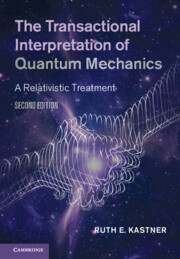Book contents
- The Transactional Interpretation of Quantum Mechanics
- The Transactional Interpretation of Quantum Mechanics
- Copyright page
- Contents
- Preface
- 1 Introduction
- 2 The Map versus the Territory
- 3 The Original TI
- 4 The New TI
- 5 The Relativistic Transactional Interpretation
- 6 Challenges, Replies, and Applications
- 7 The Metaphysics of Possibility in RTI
- 8 RTI and Spacetime
- 9 Epilogue
- References
- Index
5 - The Relativistic Transactional Interpretation
Published online by Cambridge University Press: 22 April 2022
- The Transactional Interpretation of Quantum Mechanics
- The Transactional Interpretation of Quantum Mechanics
- Copyright page
- Contents
- Preface
- 1 Introduction
- 2 The Map versus the Territory
- 3 The Original TI
- 4 The New TI
- 5 The Relativistic Transactional Interpretation
- 6 Challenges, Replies, and Applications
- 7 The Metaphysics of Possibility in RTI
- 8 RTI and Spacetime
- 9 Epilogue
- References
- Index
Summary
In this chapter, the fully relativistic form of the transactional interpretation is presented in terms of the Davies quantum direct-action theory (QDAT). Aspects of the QDAT are clarified and reinterpreted. Specifically, the coupling constant (charge) is identified as the basic amplitude for the generation of offers and confirmations, which herald the onset of non-unitarity constituting the measurement interaction. Thus, the QDAT has both unitary and non-unitary processes, the former being force-type interactions mediated by virtual photons and the latter being radiative processes in which energy is transferred via real photons. The nature of the so-called light-tight box condition for the quantum level is clarified, and it is noted that no particular cosmological structure is required for this to be fulfilled. It is argued that RTI has advantages over another relativistic collapse-type theory, rGRWf.
Keywords
Information
- Type
- Chapter
- Information
- The Transactional Interpretation of Quantum MechanicsA Relativistic Treatment, pp. 88 - 116Publisher: Cambridge University PressPrint publication year: 2022
